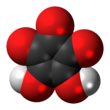
| |||
| |||
| Names | |||
|---|---|---|---|
| Preferred IUPAC name
4,5-Dihydroxycyclopent-4-ene-1,2,3-trione | |||
| Other names
Crocic acid
| |||
| Identifiers | |||
3D model (JSmol)
|
|||
| ChemSpider | |||
| ECHA InfoCard | 100.201.686 | ||
PubChem CID
|
|||
| UNII | |||
CompTox Dashboard (EPA)
|
|||
| |||
| |||
| Properties | |||
| C5H2O5 | |||
| Molar mass | 142.07 | ||
| Melting point | > 300 °C (572 °F; 573 K) (decomposes) | ||
| Acidity (pKa) | 0.80, 2.24 | ||
Except where otherwise noted, data are given for materials in their standard state (at 25 °C [77 °F], 100 kPa).
| |||
Croconic acid (also known as 4,5-dihydroxycyclopentenetrione, crocic acid or pentagonic acid) is a chemical compound with formula C5H2O5 or (C=O)3(COH)2. It has a cyclopentene backbone with two hydroxyl groups adjacent to the double bond and three ketone groups on the remaining carbon atoms. It is sensitive to light,[1] soluble in water and ethanol[2] and forms yellow crystals that decompose at 212 °C.[3]
The compound is acidic and loses the protons from the hydroxyl groups (pKa1 = 0.80±0.08 and pKa2 = 2.24±0.01 at 25 °C).[4][5] The resulting anions, hydrogencroconate C5HO−5[1] and croconate C5O2−5 are also quite stable. The croconate ion, in particular, is aromatic[6] and symmetric, as the double bond and the negative charges become delocalized over the five CO units (with two electrons, Hückel's rule means this is an aromatic configuration). The lithium, sodium and potassium croconates crystallize from water as dihydrates[7] but the orange potassium salt can be dehydrated to form a monohydrate.[1][4] The croconates of ammonium, rubidium and caesium crystallize in the anhydrous form.[7] Salts of barium, lead, silver, and others[specify] are also known.[1]
Croconic acid also forms ethers such as dimethyl croconate where the hydrogen atom of the hydroxyl group is substituted with an alkyl group.
- ^ a b c d Yamada, K.; Mizuno, N.; Hirata, Y. (1958). "Structure of croconic acid". Bulletin of the Chemical Society of Japan. 31 (5): 543–549. doi:10.1246/bcsj.31.543.
- ^ Miller, W. A. (1868). Elements of Chemistry: Theoretical and Practical (4th ed.). Longmans.[page needed]
- ^ Turner, E. Elements of Chemistry.[page needed]
- ^ a b Schwartz, L. M.; Gelb, R. I.; Yardley, J. O. (1975). "Aqueous dissociation of croconic Acid". Journal of Physical Chemistry. 79 (21): 2246–2251. doi:10.1021/j100588a009.
- ^ Gelb, R. I.; Schwartz, L. M.; Laufer, D. A.; Yardley, J. O. (1977). "The structure of aqueous croconic acid". Journal of Physical Chemistry. 81 (13): 1268–1274. doi:10.1021/j100528a010.
- ^ Georgopoulos, S. L.; Diniz, R.; Yoshida, M. I.; Speziali, N. L.; Dos Santos, H. F.; Junqueira, G. M. A.; de Oliveira, L. F. C. (2006). "Vibrational spectroscopy and aromaticity investigation of squarate salts: A theoretical and experimental approach". Journal of Molecular Structure. 794 (1–3): 63–70. Bibcode:2006JMoSt.794...63G. doi:10.1016/j.molstruc.2006.01.035.
- ^ a b Braga, D.; Maini, L.; Grepioni, F. (2002). "Croconic acid and alkali metal croconate salts: Some new insights into an old story". Chemistry – A European Journal. 8 (8): 1804–1812. doi:10.1002/1521-3765(20020415)8:8<1804::AID-CHEM1804>3.0.CO;2-C. PMID 11933108.

